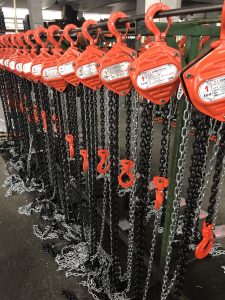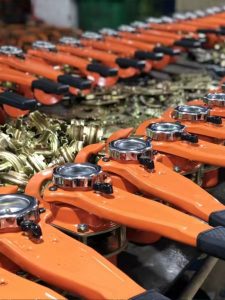Chain hoists and electric hoists are indispensable tools in industries and construction for lifting and moving heavy loads. However, chain hoists are often more widely adopted than electric hoists due to several practical, economic, and operational advantages. In this discussion, we will delve into the reasons behind the preference for chain hoists, analyzing their characteristics, benefits, and applications compared to electric hoists.
1. Cost-Effectiveness
One of the primary reasons chain hoists are more popular is their affordability. Chain hoists are typically simpler in design and manufacturing, resulting in a lower cost of production. This cost advantage makes chain hoists more accessible for small businesses, workshops, and construction sites operating on tight budgets.
Electric hoists, on the other hand, involve a motorized system, electrical components, and often more sophisticated mechanisms, leading to higher initial purchase costs. Maintenance and potential repairs also tend to be costlier due to the complexity of electric hoists. These factors make chain hoists a preferred choice for cost-conscious buyers.
2. Simplicity and Reliability
Chain hoists are renowned for their mechanical simplicity. Operated manually using a hand chain, their design consists of fewer moving parts, reducing the likelihood of breakdowns. The simplicity also means that they are easier to repair and maintain, which minimizes downtime and associated costs.
Electric hoists, while efficient, are more complex and rely on electrical systems and motors. They are more prone to electrical faults, overheating, and wear and tear of components like motors and controllers. The reliance on electricity or battery power can also introduce operational constraints, especially in remote areas with limited access to power.
3. Portability and Flexibility
Chain hoists are portable and lightweight, making them ideal for a wide range of applications. They can be easily transported and installed without requiring extensive setup or specialized equipment. This portability is particularly beneficial in industries such as construction, where hoists are frequently moved between sites or used in various locations within a single project.
Electric hoists, due to their motors and power requirements, are generally bulkier and less portable. Installing an electric hoist often involves securing a power source and additional infrastructure, limiting their flexibility in certain situations.
4. Adaptability in Various Environments
Chain hoists excel in environments where power sources are unavailable or inconsistent. They are entirely manual, allowing them to function in remote areas, outdoor sites, and during power outages. This adaptability is crucial in industries like forestry, mining, and rural construction projects.
Electric hoists, while efficient in powered environments, depend on a consistent electricity supply. Their reliance on electricity can be a disadvantage in remote or undeveloped areas where power infrastructure is absent. Furthermore, electric hoists may face performance issues in extreme temperatures or wet conditions unless specifically designed for such environments.
5. Load Capacity and Precision
Chain hoists are well-suited for heavy-duty lifting tasks. They can lift significant loads with manual effort, thanks to their mechanical advantage and gear systems. Operators have precise control over the lifting process, making chain hoists ideal for tasks requiring careful maneuvering or alignment of heavy objects.
While electric hoists can lift heavier loads more quickly, their motor-driven operation may lack the same level of manual precision. This can be a drawback in scenarios where slow, deliberate lifting and positioning are critical, such as in assembly or repair operations.
6. Durability and Longevity
Chain hoists are built to withstand harsh conditions and heavy usage. Their robust construction ensures durability, even in demanding environments. High-quality chain hoists are resistant to corrosion, wear, and mechanical fatigue, providing years of reliable service with minimal maintenance.
Electric hoists, despite their advantages in speed and automation, are more sensitive to environmental factors. Dust, moisture, and extreme temperatures can affect their electrical components and motors. Over time, this may lead to reduced efficiency or costly repairs, especially if the hoist is not adequately maintained or used in unsuitable conditions.
7. Ease of Operation
Chain hoists are straightforward to operate, requiring no special training or certifications. They are user-friendly and can be employed by workers with minimal technical knowledge. This accessibility is particularly beneficial in small-scale operations or situations where specialized labor is unavailable.
Electric hoists, while reducing manual effort, often require operators to be familiar with their controls and safety features. Improper use of electric hoists can lead to accidents or damage to the equipment, necessitating additional training and oversight.
8. Safety and Control
The manual operation of chain hoists offers greater control and safety in many applications. Operators can adjust the lifting speed and direction in real time, responding to the load’s behavior and environmental conditions. This level of control reduces the risk of accidents and allows for safe handling of delicate or irregularly shaped loads.
Electric hoists, while equipped with safety features such as limit switches and emergency stops, may not provide the same level of tactile feedback as manual chain hoists. Their reliance on automated mechanisms can sometimes lead to mishaps if not monitored carefully.
9. Versatility in Applications
Chain hoists are versatile tools used across a broad range of industries. From construction and manufacturing to shipbuilding and event setup, their ability to lift and position heavy loads makes them indispensable in diverse scenarios. Chain hoists can also be mounted in various configurations, such as on fixed points, trolleys, or scaffolding, further enhancing their utility.
Electric hoists are also versatile but may face limitations in environments where power sources or infrastructure are unavailable. Their higher cost and complexity can also make them less attractive for applications where simpler tools suffice.
10. Energy Efficiency
Chain hoists require no external power source, relying solely on manual effort to operate. This makes them inherently energy-efficient and environmentally friendly, as they do not consume electricity or produce emissions. In industries prioritizing sustainability or operating in off-grid locations, this characteristic is a significant advantage.
Electric hoists, while efficient in powered environments, contribute to energy consumption and may incur higher operating costs over time. Their reliance on electricity also makes them less suitable for applications focused on minimizing energy use or operating in eco-sensitive areas.
11. Customization and Scalability
Chain hoists are available in a wide range of capacities, from light-duty models for small workshops to heavy-duty variants for industrial applications. Their modular design allows for easy customization and scalability to meet specific needs. Accessories such as different lengths of chains, hooks, and mounting options further enhance their versatility.
Electric hoists, while also available in various capacities, may require more significant investment and planning to customize or scale. Their reliance on compatible electrical systems can sometimes limit their adaptability in certain setups.
12. Reduced Maintenance Requirements
Maintenance for chain hoists is relatively simple and inexpensive. Regular lubrication, inspection for wear and tear, and occasional replacement of parts like chains or hooks are typically sufficient to keep them in optimal condition. This low maintenance requirement makes chain hoists a practical choice for users seeking minimal operational overhead.
Electric hoists, due to their complex systems, require more frequent and specialized maintenance. Components like motors, electrical wiring, and controllers may need periodic servicing or replacement, increasing maintenance costs and potential downtime.
Conclusion
Chain hoists are more widely used than electric hoists for several compelling reasons. Their cost-effectiveness, simplicity, portability, adaptability, and durability make them a versatile and reliable choice for many industries and applications. While electric hoists offer advantages in speed and automation, their higher cost, reliance on electricity, and increased maintenance requirements often make them less practical for certain scenarios.
The decision between chain and electric hoists ultimately depends on the specific needs of the user, including budget, operational environment, and the nature of the tasks involved. For many businesses and projects, chain hoists strike an optimal balance between performance and practicality, ensuring their continued widespread use across the globe.

